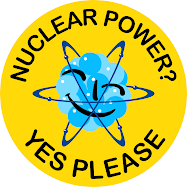Get the entire report in Rich Text Format, MS Word or as a PDF image. Or see this page for specific sections.
In [extreme] summary, the report endorses a 'cap and trade' scheme to be started sooner rather than later. In such a scheme, government sets the cap and issues some sort of emissions certificates. Issuing fewer certificates over time has the desired effect of reducing emissions. The price for the certificates is set by the market leading to competition by all technologies. The least cost abatement technologies would then be deployed and thrive in a sort of economic Darwinism.
I am pleased to see an objective consideration of nuclear as well as a discussion of renewable technologies within the context of their development status and capabilities. A few quotes:
In [extreme] summary, the report endorses a 'cap and trade' scheme to be started sooner rather than later. In such a scheme, government sets the cap and issues some sort of emissions certificates. Issuing fewer certificates over time has the desired effect of reducing emissions. The price for the certificates is set by the market leading to competition by all technologies. The least cost abatement technologies would then be deployed and thrive in a sort of economic Darwinism.
I am pleased to see an objective consideration of nuclear as well as a discussion of renewable technologies within the context of their development status and capabilities. A few quotes:
Low-emissions technologies – such as clean coal, gas, nuclear, solar, wind, hydro, and geothermal – should compete on an equal basis.
...displacement of Australian production could result in lower global emissions if the additional production were to occur in jurisdictions with lower emissions profiles (for example, because they use electricity generated by hydro, gas or nuclear power).
Large-scale emissions abatement will be dependent on the wider use of existing low-emissions technologies (such as nuclear and wind), the development and diffusion of new and currently immature technologies (such as carbon capture and storage, geothermal and large-scale solar), and widespread take up of energy efficiency and demand reduction opportunities.
...the ‘take off’ of the Clean Development Mechanism has not met the expectations of many [due to] the exclusion of some activities from eligibility, notably nuclear energy and carbon capture and storage projects
The Energy Supply Association of Australia (2006) found that to achieve a reduction of 30 per cent of electricity-related emissions from 2000 levels without nuclear and carbon capture and storage technologies would approximately double total electricity production costs compared with the scenario where these technologies were available.
And there are numerous references to our 'vast reserves of uranium'.
If one considers just the above statements... 'nuclear and wind are mature', 'nuclear and carbon capture required to achieve a cost effective 30% emissions reduction' [let alone anything larger - say 60%], 'excluding nuclear and carbon capture is why current emission reduction progress has been disappointing', etc; the conclusion appears to be that nuclear is the only available, mature technology capable of significant and cost effective emissions reductions. I would certainly say that we can't get 'there' without it.
If one considers just the above statements... 'nuclear and wind are mature', 'nuclear and carbon capture required to achieve a cost effective 30% emissions reduction' [let alone anything larger - say 60%], 'excluding nuclear and carbon capture is why current emission reduction progress has been disappointing', etc; the conclusion appears to be that nuclear is the only available, mature technology capable of significant and cost effective emissions reductions. I would certainly say that we can't get 'there' without it.















No comments:
Post a Comment